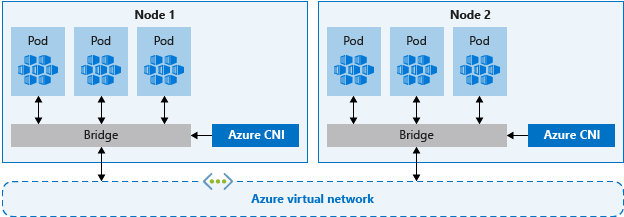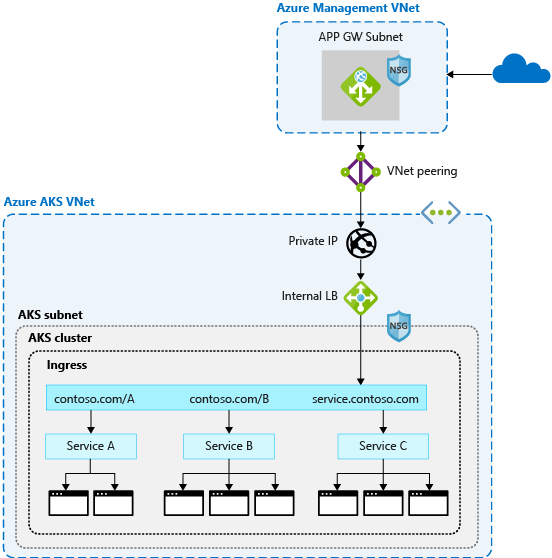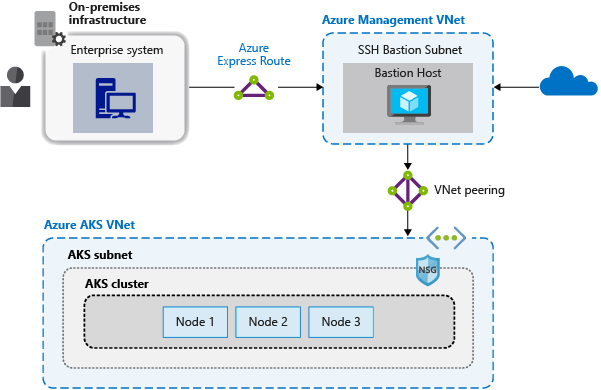Best practices for network connectivity and security in Azure Kubernetes Service (AKS)
As you create and manage clusters in Azure Kubernetes Service (AKS), you provide network connectivity for your nodes and applications. These network resources include IP address ranges, load balancers, and ingress controllers.
This best practices article focuses on network connectivity and security for cluster operators. In this article, you learn how to:
- Compare the kubenet and Azure Container Networking Interface (CNI) network modes in AKS.
- Plan for required IP addressing and connectivity.
- Distribute traffic using load balancers, ingress controllers, or a web application firewall (WAF).
- Securely connect to cluster nodes.
Choose the appropriate network model
Best practice guidance
Use Azure CNI networking in AKS for integration with existing virtual networks or on-premises networks. This network model allows greater separation of resources and controls in an enterprise environment.
Virtual networks provide the basic connectivity for AKS nodes and customers to access your applications. There are two different ways to deploy AKS clusters into virtual networks:
- Azure CNI networking: Deploys into a virtual network and uses the Azure CNI Kubernetes plugin. Pods receive individual IPs that can route to other network services or on-premises resources.
- Kubenet networking: Azure manages the virtual network resources as the cluster is deployed and uses the kubenet Kubernetes plugin.
Azure CNI and kubenet are both valid options for production deployments.
CNI Networking
Azure CNI is a vendor-neutral protocol that lets the container runtime make requests to a network provider. It assigns IP addresses to pods and nodes, and provides IP address management (IPAM) features as you connect to existing Azure virtual networks. Each node and pod resource receives an IP address in the Azure virtual network. There's no need for extra routing to communicate with other resources or services.

Notably, Azure CNI networking for production allows for separation of control and management of resources. From a security perspective, you often want different teams to manage and secure those resources. With Azure CNI networking, you connect to existing Azure resources, on-premises resources, or other services directly via IP addresses assigned to each pod.
When you use Azure CNI networking, the virtual network resource is in a separate resource group to the AKS cluster. Delegate permissions for the AKS cluster identity to access and manage these resources. The cluster identity used by the AKS cluster must have at least Network Contributor permissions on the subnet within your virtual network.
If you wish to define a custom role instead of using the built-in Network Contributor role, the following permissions are required:
Microsoft.Network/virtualNetworks/subnets/join/actionMicrosoft.Network/virtualNetworks/subnets/read
By default, AKS uses a managed identity for its cluster identity. However, you can use a service principal instead.
- For more information about AKS service principal delegation, see Delegate access to other Azure resources.
- For more information about managed identities, see Use managed identities.
As each node and pod receives its own IP address, plan out the address ranges for the AKS subnets. Keep the following criteria in mind:
- The subnet must be large enough to provide IP addresses for every node, pod, and network resource you deploy.
- With both kubenet and Azure CNI networking, each running node has default limits to the number of pods.
- Avoid using IP address ranges that overlap with existing network resources.
- It's necessary to allow connectivity to on-premises or peered networks in Azure.
- To handle scale out events or cluster upgrades, you need extra IP addresses available in the assigned subnet.
- This extra address space is especially important if you use Windows Server containers, as those node pools require an upgrade to apply the latest security patches. For more information on Windows Server nodes, see Upgrade a node pool in AKS.
To calculate the IP address required, see Configure Azure CNI networking in AKS.
When creating a cluster with Azure CNI networking, you specify other address ranges for the cluster, such as the Docker bridge address, DNS service IP, and service address range. In general, make sure these address ranges don't overlap each other or any networks associated with the cluster, including any virtual networks, subnets, on-premises and peered networks.
For the specific details around limits and sizing for these address ranges, see Configure Azure CNI networking in AKS.
Kubenet networking
Although kubenet doesn't require you to configure the virtual networks before deploying the cluster, there are disadvantages to waiting, such as:
- Since nodes and pods are placed on different IP subnets, User Defined Routing (UDR) and IP forwarding routes traffic between pods and nodes. This extra routing may reduce network performance.
- Connections to existing on-premises networks or peering to other Azure virtual networks can be complex.
Since you don't create the virtual network and subnets separately from the AKS cluster, Kubenet is ideal for the following scenarios:
- Small development or test workloads.
- Simple websites with low traffic.
- Lifting and shifting workloads into containers.
For production deployments, both kubenet and Azure CNI are valid options. Environments which require separation of control and management, Azure CNI may the preferred option. Additionally, kubenet is suited for Linux only environments where IP address range conservation is a priority.
You can also configure your own IP address ranges and virtual networks using kubenet. Like Azure CNI networking, these address ranges shouldn't overlap each other or any networks associated with the cluster (virtual networks, subnets, on-premises and peered networks).
For the specific details around limits and sizing for these address ranges, see Use kubenet networking with your own IP address ranges in AKS.
Distribute ingress traffic
Best practice guidance
To distribute HTTP or HTTPS traffic to your applications, use ingress resources and controllers. Compared to an Azure load balancer, ingress controllers provide extra features and can be managed as native Kubernetes resources.
While an Azure load balancer can distribute customer traffic to applications in your AKS cluster, it's limited in understanding that traffic. A load balancer resource works at layer 4 and distributes traffic based on protocol or ports.
Most web applications using HTTP or HTTPS should use Kubernetes ingress resources and controllers, which work at layer 7. Ingress can distribute traffic based on the URL of the application and handle TLS/SSL termination. Ingress also reduces the number of IP addresses you expose and map.
With a load balancer, each application typically needs a public IP address assigned and mapped to the service in the AKS cluster. With an ingress resource, a single IP address can distribute traffic to multiple applications.

There are two components for ingress:
- An ingress resource
- An ingress controller
Ingress resource
The ingress resource is a YAML manifest of kind: Ingress. It defines the host, certificates, and rules to route traffic to services running in your AKS cluster.
The following example YAML manifest distributes traffic for myapp.com to one of two services, blogservice or storeservice, and directs the customer to one service or the other based on the URL they access.
apiVersion: networking.k8s.io/v1
kind: Ingress
metadata:
name: myapp-ingress
spec:
ingressClassName: PublicIngress
tls:
- hosts:
- myapp.com
secretName: myapp-secret
rules:
- host: myapp.com
http:
paths:
- path: /blog
backend:
service:
name: blogservice
port: 80
- path: /store
backend:
service:
name: storeservice
port: 80
Ingress controller
An ingress controller is a daemon that runs on an AKS node and watches for incoming requests. Traffic is then distributed based on the rules defined in the ingress resource. While the most common ingress controller is based on NGINX, AKS doesn't restrict you to a specific controller. You can use Contour, HAProxy, Traefik, etc.
Ingress controllers must be scheduled on a Linux node. Indicate that the resource should run on a Linux-based node using a node selector in your YAML manifest or Helm chart deployment. For more information, see Use node selectors to control where pods are scheduled in AKS.
Ingress with the application routing addon
The application routing addon is the recommended way to configure an Ingress controller in AKS. The application routing addon is a fully managed, ingress controller for Azure Kubernetes Service (AKS) that provides the following features:
Easy configuration of managed NGINX Ingress controllers based on Kubernetes NGINX Ingress controller.
Integration with Azure DNS for public and private zone management.
SSL termination with certificates stored in Azure Key Vault.
For more information about the application routing add-on, see Managed NGINX ingress with the application routing add-on.
Secure traffic with a web application firewall (WAF)
Best practice guidance
To scan incoming traffic for potential attacks, use a web application firewall (WAF) such as Barracuda WAF for Azure or Azure Application Gateway. These more advanced network resources can also route traffic beyond just HTTP and HTTPS connections or basic TLS termination.
Typically, an ingress controller is a Kubernetes resource in your AKS cluster that distributes traffic to services and applications. The controller runs as a daemon on an AKS node, and consumes some of the node's resources, like CPU, memory, and network bandwidth. In larger environments, you may want to consider the following:
- Offload some of this traffic routing or TLS termination to a network resource outside of the AKS cluster.
- Scan incoming traffic for potential attacks.

For that extra layer of security, a web application firewall (WAF) filters the incoming traffic. With a set of rules, the Open Web Application Security Project (OWASP) watches for attacks like cross-site scripting or cookie poisoning. Azure Application Gateway (currently in preview in AKS) is a WAF that integrates with AKS clusters, locking in these security features before the traffic reaches your AKS cluster and applications.
Since other third-party solutions also perform these functions, you can continue to use existing investments or expertise in your preferred product.
Load balancer or ingress resources continually run in your AKS cluster and refine the traffic distribution. App Gateway can be centrally managed as an ingress controller with a resource definition. To get started, create an Application Gateway Ingress controller.
Control traffic flow with network policies
Best practice guidance
Use network policies to allow or deny traffic to pods. By default, all traffic is allowed between pods within a cluster. For improved security, define rules that limit pod communication.
Network policy is a Kubernetes feature available in AKS that lets you control the traffic flow between pods. You allow or deny traffic to the pod based on settings such as assigned labels, namespace, or traffic port. Network policies are a cloud-native way to control the flow of traffic for pods. As pods are dynamically created in an AKS cluster, required network policies can be automatically applied.
To use network policy, enable the feature when you create a new AKS cluster. You can't enable network policy on an existing AKS cluster. Plan ahead to enable network policy on the necessary clusters.
Note
Network policy should only be used for Linux-based nodes and pods in AKS.
You create a network policy as a Kubernetes resource using a YAML manifest. Policies are applied to defined pods, with ingress or egress rules defining traffic flow.
The following example applies a network policy to pods with the app: backend label applied to them. The ingress rule only allows traffic from pods with the app: frontend label.
kind: NetworkPolicy
apiVersion: networking.k8s.io/v1
metadata:
name: backend-policy
spec:
podSelector:
matchLabels:
app: backend
ingress:
- from:
- podSelector:
matchLabels:
app: frontend
To get started with policies, see Secure traffic between pods using network policies in Azure Kubernetes Service (AKS).
Securely connect to nodes through a bastion host
Best practice guidance
Don't expose remote connectivity to your AKS nodes. Create a bastion host, or jump box, in a management virtual network. Use the bastion host to securely route traffic into your AKS cluster to remote management tasks.
You can complete most operations in AKS using the Azure management tools or through the Kubernetes API server. AKS nodes are only available on a private network and aren't connected to the public internet. To connect to nodes and provide maintenance and support, route your connections through a bastion host, or jump box. Verify this host lives in a separate, securely peered management virtual network to the AKS cluster virtual network.

You should also secure the management network for the bastion host. Use an Azure ExpressRoute or VPN gateway to connect to an on-premises network and control access using network security groups.
Next steps
This article focused on network connectivity and security. For more information about network basics in Kubernetes, see Network concepts for applications in Azure Kubernetes Service (AKS)
Feedback
Kommer snart: I hele 2024 udfaser vi GitHub-problemer som feedbackmekanisme for indhold og erstatter det med et nyt feedbacksystem. Du kan få flere oplysninger under: https://aka.ms/ContentUserFeedback.
Indsend og få vist feedback om